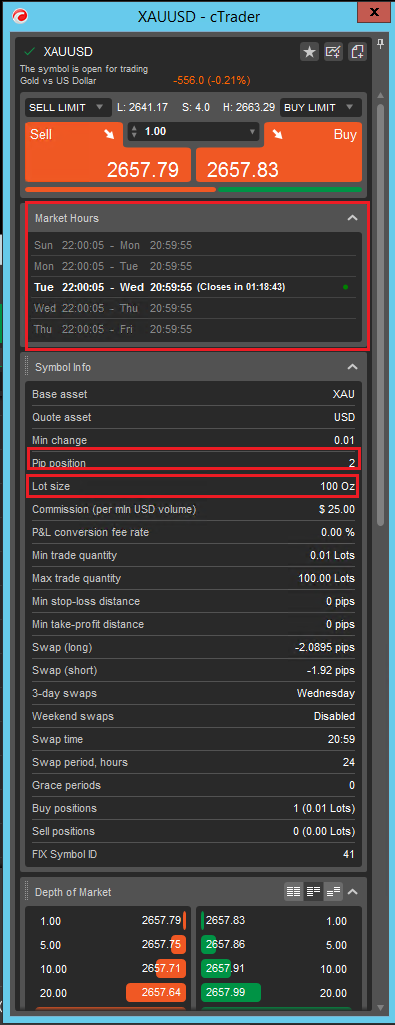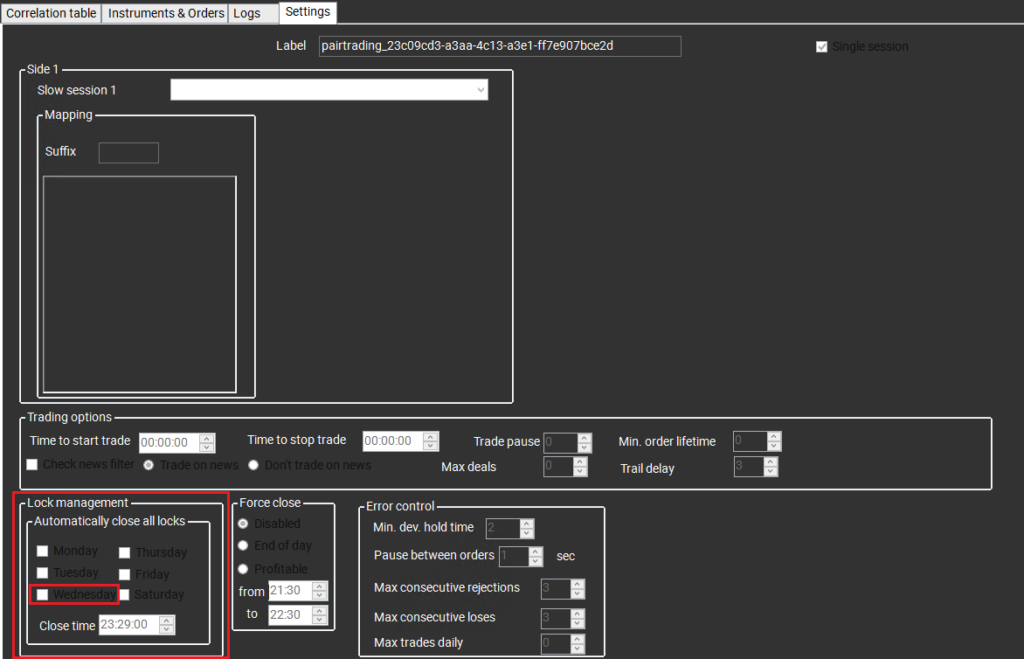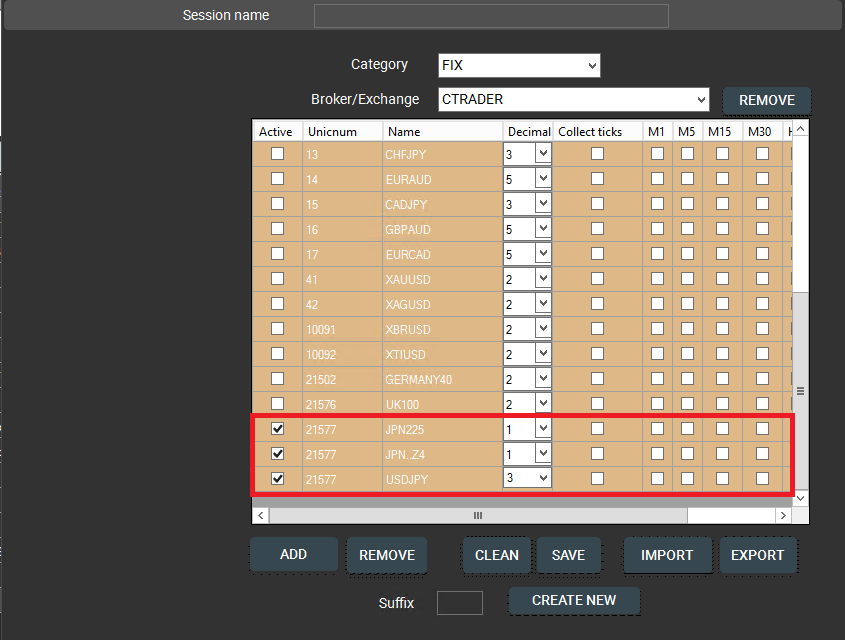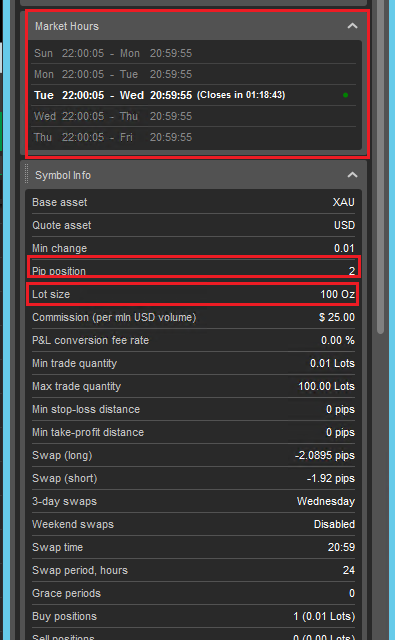إعداد تداول الأزواج بين العقود الآجلة مقابل السوق الفوري 04/10/2024 – Posted in: Arbitrage Software, Forex trading – Tags: forex trading, futures trading, pairs trading, pairs trading software, pairs trading strategy, sharptrader, statistical arbitrage
نظرة عامة:
- المزايا الرئيسية لاستراتيجية التداول بالزوج مع العقود الآجلة مقابل الأدوات الفورية
- الحصول على مواصفات أدوات التداول
- إعداد الرموز في موصلات SharpTrader
- إعدادات استراتيجية التداول
- الخلاصة
- الأسئلة الشائعة
المزايا الرئيسية لاستخدام استراتيجية التداول بالزوج مع العقود الآجلة مقابل الأدوات الفورية:
- تقليل مخاطر السوق: من خلال تداول الأصول ذات الارتباط العالي مثل العقود الآجلة والأدوات الفورية، يمكنك تحوط مراكزك وتقليل تأثير تقلبات السوق.
- فرص المراجحة (الأربيتراج): غالبًا ما تختلف أسعار العقود الآجلة عن الأسعار الفورية بسبب كفاءة السوق. تتيح لك استراتيجية المراجحة في التداول بالزوج الاستفادة من هذه الفروق وتحقيق الربح من الأخطاء في التسعير.
- فوائد الرافعة المالية: عادة ما توفر العقود الآجلة رافعة مالية أعلى مقارنةً بالأدوات الفورية، مما يمكّنك من تضخيم الأرباح المحتملة مع الحفاظ على توازن المخاطر بفضل طبيعة الاستراتيجية التحوطية.
- انخفاض تكاليف المعاملات: يمكن أن تتضمن العقود الآجلة تكاليف معاملات أقل، خاصة مع الأحجام الكبيرة للعقود، مما يجعل الاستراتيجية أكثر كفاءة من حيث التكلفة.
- تنويع المحفظة التجارية: إن الاحتفاظ بمراكز في كل من الأسواق الآجلة والفورية يتيح لك تنويع تعرضك وتقليل مخاطر الاعتماد على سوق واحد.
- كفاءة رأس المال: عادة ما تتطلب العقود الآجلة هامشًا أوليًا أقل من الاحتفاظ بالمراكز الفورية، مما يجعلها وسيلة أكثر كفاءة من حيث رأس المال للتحوط أو المضاربة.
- مرونة التداول: يمكنك تعديل مراكزك بناءً على ظروف السوق، باستخدام العقود الآجلة لتحقيق مكاسب قصيرة الأجل والأدوات الفورية للاحتفاظ طويل الأجل.
- تقليل مخاطر العملات: العقود الآجلة تكون عادةً موحدة من حيث أحجام العقود والعملات، مما يقلل من مخاطر تقلبات أسعار الصرف مقارنة بالتداول الفوري.
هذه المجموعة من التداول بالزوج بين العقود الآجلة والأدوات الفورية توفر نهجًا قويًا لتحقيق توازن بين المخاطر والمكاسب مع الاستفادة من عدم كفاءة السوق.
كيفية إعداد استراتيجية المراجحة في التداول بالزوج في SharpTrader للعقود الآجلة مقابل الأدوات الفورية
إعداد موصل SharpTrader
لبدء العمل، من المهم التحقق من مواصفات كل أداة تداول لضبط الجلسة بشكل صحيح:
- اسم الرمز
- عدد الأماكن العشرية
- حجم العقد
- قيمة النقطة (Tick Value)
- أوقات التداول
يمكنك الحصول على هذه المعلومات من الوسيط الخاص بك بطلب مواصفات الأدوات أو التحقق مباشرةً من منصة التداول الخاصة بك.
على سبيل المثال، في cTrader، نفترض أننا نتداول في مؤشر JPN225 مقابل العقود الآجلة لـ JPN225.

إليك عينة من مواصفات هذه الأدوات:

ستحتاج أيضًا إلى تعديل أوقات التداول بناءً على أوقات VPS الخاص بك وأوقات خادم الوسيط. على سبيل المثال، إذا كان VPS الخاص بك في UTC (GMT=0) ويعمل الوسيط في GMT+3، فستقوم بتعديل وقت التداول إلى 00:00–21:00.
إعداد رموز التداول في SharpTrader:
أضف الرموز في إعدادات الجلسة تحت علامة تبويب الرموز في منصة المراجحة SharpTrader. سنأخذ على سبيل المثال مؤشر سوق الأسهم الياباني (JPN225) مقابل العقود الآجلة له (JPN225.Z4) ونضيف أيضًا USDJPY. للتأكد من حساب الأرباح بشكل صحيح، يجب عليك إضافة العملة الأساسية للمؤشر أو العقد الآجل – في هذه الحالة الين الياباني (JPY) لـ JPN225.

في إعدادات الجلسة تحت علامة التبويب المؤشرات، أدخل مضاعف اللوت وفقًا لـ حجم العقد واختر العملة الأساسية المناسبة.

إذا كنت تستخدم حسابين، قم بتكوين الجلسات لكل حساب بشكل مناسب.
إعداد استراتيجية التداول بالزوج في SharpTrader
في علامة تبويب الإعدادات، أوصي بإلغاء تفعيل إدارة القفل أيام الأربعاء. عادةً ما يتم استخدام هذه الوظيفة لتجنب تأثير الفوائد الثلاثية على العقود. ومع ذلك، في استراتيجية المراجحة للتداول بالزوج، قد يكون الخسارة من القفل المغلق أكبر من تكلفة الفوائد الثلاثية للمؤشرات.
بعد ذلك، أضف الرموز في جدول الاستراتيجية باستخدام نفس الأسماء التي استخدمتها في إعدادات الجلسة.

حساب اللوت:
عند حساب أحجام اللوت، يجب أن تأخذ في الاعتبار حجم العقد وقيمة النقطة (Tick Value). ابدأ باستخدام الحسابات التجريبية لفتح الأقفال يدويًا وتأكد من أن الأسعار تتحرك بالتزامن للأدوات المرتبطة عند كل تغير في السوق. تأكد من أن وقف الخسارة (SL) كبير بما يكفي لمنع الإغلاق المبكر في حالة حدوث انحرافات كبيرة. اختبر إعدادك لمدة أسبوع على الأقل في الحسابات التجريبية للتعرف على المشكلات المحتملة قبل الانتقال إلى الحسابات الحقيقية.

يمكنك استخدام قيمنا المعدة مسبقًا للإعدادات الأولية. إذا زادت حجم اللوت، تذكر توسيع نطاق SL وTP والربح الأدنى ومسافة التتبع والتقدم بمقدار 10 أو 100 وما إلى ذلك. يمكنك التفكير في استخدام نفس الزوج مع قيم مختلفة لـ Z-Index (على سبيل المثال 2، 2.5، 2.8) للاستفادة من فروق الأسعار الكبيرة، ولكن ذلك سيزيد من المخاطر.
الأسئلة الشائعة
س: هل يمكنني استخدام استراتيجية المراجحة للتداول بالزوج على حساب واحد؟
ج: نعم، يمكنك ذلك بشرط أن يوفر الوسيط كل من المؤشرات والأدوات الفورية للأصول الأساسية نفسها وألا يقوم بتنعيم فروق الأسعار بينها. إذا لم تكتشف الاستراتيجية انحرافات بين المستقبل والمؤشر لفترة طويلة، ففكر في تغيير الوسيط أو إعداد الاستراتيجية عبر وسيطين.
س: هل يمكنني تداول العملات المرتبطة (على سبيل المثال EURCAD مقابل USDCAD) أو المؤشرات المرتبطة (على سبيل المثال DE40 مقابل FR40)؟
ج: نعم، يمكنك ذلك، لكن هذا الإعداد يحمل عادةً مخاطر أعلى. ومع ذلك، يمكن تحقيق نتائج أقل مخاطرة باستخدام أزواج مثل BRENT مقابل WTI، التي تميل إلى إظهار ارتباط أفضل من حيث التحكم في المخاطر.
س: كيف أحسب حجم اللوت الصحيح لاستراتيجية المراجحة للتداول بالزوج؟
ج: يجب حساب حجم اللوت بناءً على حجم العقد وقيمة النقطة للأدوات التي تتداولها. نوصي بالبدء بحسابات تجريبية لفتح ومراقبة حركة الأسعار بشكل مشابه لكلا الأداتين المرتبطتين.
س: ما هو أفضل وقت للتداول باستخدام استراتيجية التداول بالزوج؟
ج: يعتمد أفضل وقت على السيولة والتقلبات في الأدوات. بشكل عام، يكون حجم التداول مرتفعًا خلال الجلسات الرئيسية (على سبيل المثال لندن، نيويورك). بالإضافة إلى ذلك، يمكن أن يساعد مراقبة الأحداث الاقتصادية المهمة في العثور على فرص المراجحة.
س: هل يمكنني ضبط Z-Index للتداول عدة مرات باستخدام نفس الزوج؟
ج: نعم، يمكنك استخدام قيم Z-Index مختلفة لنفس الزوج، على سبيل المثال 2، 2.5، و2.8، للاستفادة من فروق الأسعار الكبيرة. ومع ذلك، فإن ذلك يزيد من المخاطر، لذا نوصي باختبار هذه الطريقة أولاً على الحسابات التجريبية للعثور على الإعداد الأمثل.
س: ماذا أفعل إذا كان الوسيط الخاص بي لا يدعم العقود الآجلة والأدوات الفورية معًا؟
ج: إذا كان الوسيط الخاص بك لا يدعم كلاً من العقود الآجلة والأدوات الفورية للأصل نفسه، يمكنك التبديل إلى وسيط يوفر كليهما أو إعداد الاستراتيجية للتداول بين وسيطين منفصلين، واحد للعقود الآجلة والآخر للأدوات الفورية.
الخلاصة
توفر استراتيجية التداول بالزوج بين العقود الآجلة والأدوات الفورية نهجًا فريدًا وقويًا لتقليل المخاطر والاستفادة من عدم كفاءة السوق. من خلال الإعداد الصحيح، يمكن للمتداولين تحوط المراكز بفعالية، الاستفادة من فرص المراجحة، وتحقيق أقصى كفاءة رأس المال. قبل استخدام هذه الاستراتيجية في الأسواق الحية، تأكد من اختبارها بشكل شامل على الحسابات التجريبية وإجراء التعديلات اللازمة لتناسب أسلوب التداول الخاص بك وتحمل المخاطر.
إذا كنت ترغب في الحصول على إعداد مثالي للتداول بين العقود الآجلة والأدوات الفورية، يرجى الاتصال بنا. إذا لم تكن تمتلك الاستراتيجية بعد، سنقدم لك خصمًا خاصًا للبدء.
 English
English Deutsch
Deutsch 日本語
日本語 한국어
한국어 Español
Español Português
Português Indonesia
Indonesia Tiếng Việt
Tiếng Việt 中文
中文





